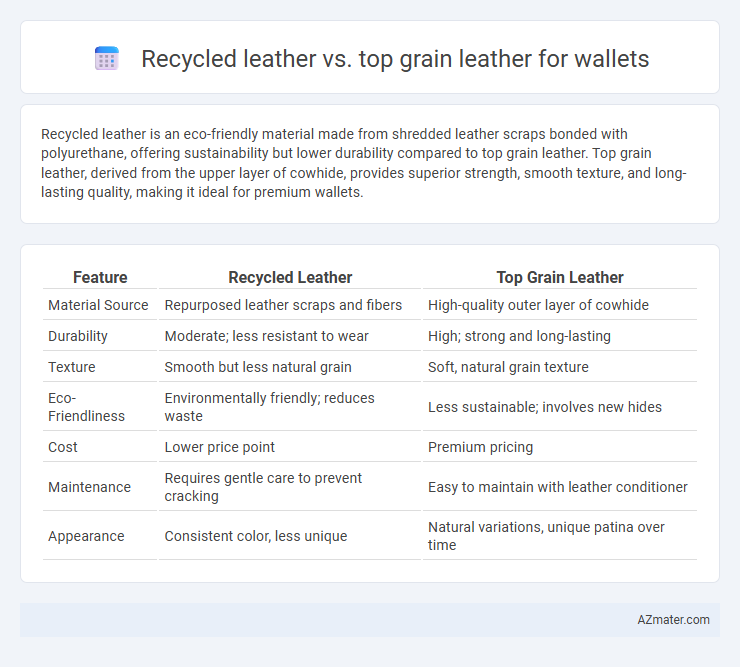Recycled leather is an eco-friendly material made from shredded leather scraps bonded with polyurethane, offering sustainability but lower durability compared to top grain leather. Top grain leather, derived from the upper layer of cowhide, provides superior strength, smooth texture, and long-lasting quality, making it ideal for premium wallets.
Table of Comparison
| Feature | Recycled Leather | Top Grain Leather |
|---|---|---|
| Material Source | Repurposed leather scraps and fibers | High-quality outer layer of cowhide |
| Durability | Moderate; less resistant to wear | High; strong and long-lasting |
| Texture | Smooth but less natural grain | Soft, natural grain texture |
| Eco-Friendliness | Environmentally friendly; reduces waste | Less sustainable; involves new hides |
| Cost | Lower price point | Premium pricing |
| Maintenance | Requires gentle care to prevent cracking | Easy to maintain with leather conditioner |
| Appearance | Consistent color, less unique | Natural variations, unique patina over time |
Introduction to Recycled Leather and Top Grain Leather
Recycled leather is made by combining leather scraps and fibers bonded with polyurethane or latex, offering an eco-friendly alternative with a lower environmental impact compared to traditional leather. Top grain leather, sourced from the outer layer of the hide, is prized for its durability, smooth texture, and premium quality, making it a popular choice for high-end wallets. While recycled leather provides affordability and sustainability, top grain leather delivers superior strength and natural aging characteristics.
How Each Leather Type is Made
Recycled leather is made by shredding leftover leather scraps, mixing them with polyurethane or natural latex binders, and then compressing the mixture into sheets, offering an eco-friendly alternative using waste materials. Top grain leather is crafted from the outer layer of a cowhide, sanded and buffed to remove imperfections before being dyed and finished, providing a durable and smooth surface. The manufacturing process of recycled leather emphasizes sustainability, while top grain leather prioritizes quality and natural texture.
Texture and Appearance Comparison
Top grain leather showcases a smooth, consistent texture with natural grain patterns, exuding a rich, luxurious appearance ideal for premium wallets. Recycled leather exhibits a more varied texture, often less uniform with visible material blends that can create a rugged or unique aesthetic. While top grain leather offers classic elegance and durability, recycled leather provides an eco-friendly option with distinctive visual character.
Durability and Longevity
Top grain leather offers superior durability and longevity compared to recycled leather due to its natural grain structure and resistance to wear and tear. Recycled leather, made from bonded leather scraps, tends to degrade faster and is less resilient to daily use, making it less ideal for long-lasting wallets. Investing in top grain leather wallets ensures enduring quality and sustained aesthetic appeal over time.
Environmental Impact and Sustainability
Recycled leather significantly reduces waste by repurposing leather scraps and offcuts, lowering the demand for virgin leather production which is resource-intensive and often linked to deforestation and high carbon emissions. Top grain leather, while durable and high quality, involves animal tanning processes that contribute to water pollution and greenhouse gases, making its environmental footprint larger. Choosing recycled leather wallets supports circular economy practices and helps minimize landfill waste, promoting a more sustainable and eco-friendly product lifecycle.
Cost Differences: Recycled vs Top Grain
Recycled leather wallets generally cost less than top grain leather due to the use of repurposed leather fibers and lower processing expenses. Top grain leather wallets incur higher prices reflecting the durability, natural texture, and premium quality of the outermost hide layer. Consumers often pay a premium for top grain leather's superior aging and wear resistance compared to the more budget-friendly recycled leather options.
Maintenance and Care Requirements
Recycled leather wallets require minimal maintenance, typically needing only occasional wiping with a damp cloth to remove dirt and prevent buildup, while they are less prone to cracking compared to natural leather. Top grain leather wallets demand regular conditioning with leather-specific creams or oils to maintain suppleness and prevent drying or cracking over time. Proper care of top grain leather includes avoiding prolonged exposure to moisture and direct sunlight, which helps preserve its natural texture and durability.
Performance in Daily Wallet Use
Top grain leather offers superior durability and develops a rich patina with daily use, making it highly resistant to wear, scratches, and moisture, which enhances wallet longevity. Recycled leather often contains bonded fibers combined with polyurethane or latex, resulting in lower durability and susceptibility to peeling or cracking over time under frequent handling. For everyday wallets, top grain leather provides consistent performance and maintains structural integrity far better than recycled leather alternatives.
Pros and Cons of Recycled Leather Wallets
Recycled leather wallets offer an eco-friendly alternative by repurposing leather scraps, reducing waste and conserving resources, making them a sustainable choice for environmentally conscious consumers. These wallets typically have a lower cost compared to top grain leather, but they may lack the durability and natural texture that premium top grain leather provides, potentially resulting in a shorter lifespan. The quality of recycled leather varies depending on the manufacturing process, and some products might feel less supple or show inconsistencies compared to the uniform finish of top grain leather wallets.
Pros and Cons of Top Grain Leather Wallets
Top grain leather wallets offer exceptional durability and develop a rich patina over time, enhancing their aesthetic appeal and longevity. They are resistant to stains and scratches, making them suitable for daily use, but tend to be more expensive than recycled leather options. However, top grain leather wallets may require occasional conditioning to maintain suppleness and prevent cracking.

Infographic: Recycled leather vs Top grain leather for Wallet
 azmater.com
azmater.com